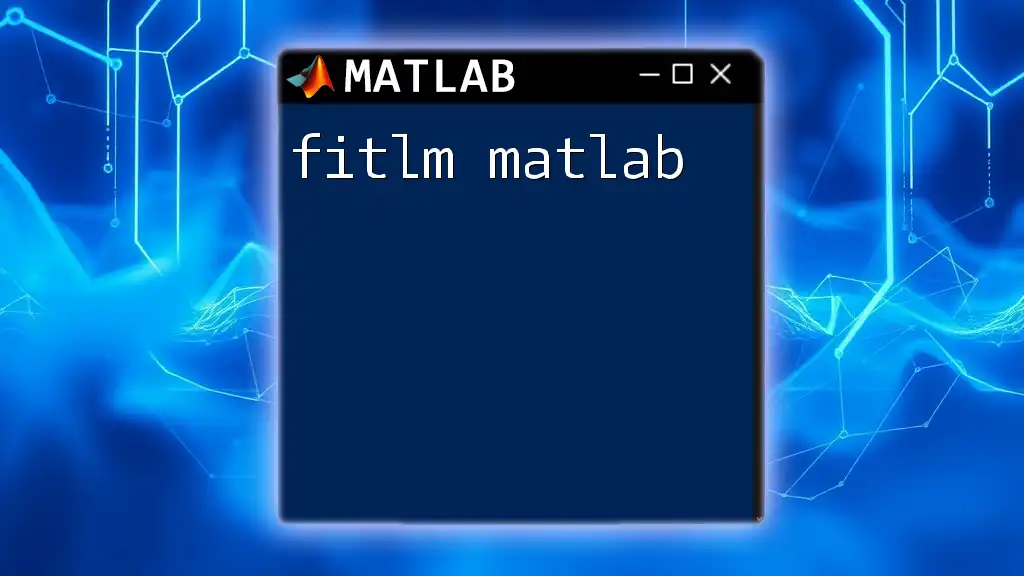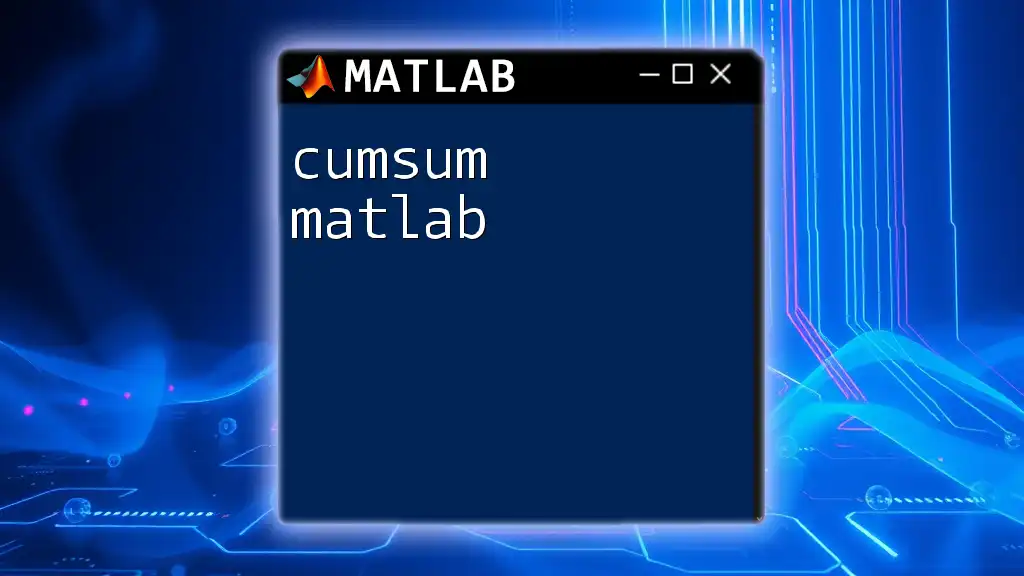The Fourier spectrum in MATLAB allows users to analyze the frequency components of a signal by computing its Fast Fourier Transform (FFT).
Here's a code snippet to illustrate how to compute and plot the Fourier spectrum in MATLAB:
% Sample Signal
Fs = 1000; % Sampling frequency
t = 0:1/Fs:1-1/Fs; % Time vector
x = sin(2*pi*100*t) + 0.5*sin(2*pi*200*t); % Signal with two frequencies
% Compute FFT
Y = fft(x);
L = length(x);
P2 = abs(Y/L); % Two-sided spectrum
P1 = P2(1:L/2+1); % Single-sided spectrum
P1(2:end-1) = 2*P1(2:end-1); % Correct amplitude
% Frequency vector
f = Fs*(0:(L/2))/L;
% Plotting
figure;
plot(f,P1)
title('Single-Sided Amplitude Spectrum of X(t)')
xlabel('Frequency (f)')
ylabel('|P1(f)|')
grid on;
Understanding the Fourier Transform
What is the Fourier Transform?
The Fourier Transform (FT) is a mathematical transformation that plays a critical role in converting time-domain signals into their corresponding frequency-domain representation. It essentially decomposes a signal into its constituent frequencies, providing insights into the signal’s oscillatory nature.
There are two primary forms of the Fourier Transform:
- Continuous Fourier Transform (CFT): Deals with continuous signals, useful for analog signals and provides a continuous spectrum.
- Discrete Fourier Transform (DFT): Useful for digital signals, applies to discrete data points. This transform is faster and more efficient for numerical computations and is implemented using the Fast Fourier Transform (FFT) algorithm.
Applications of Fourier Transform
The Fourier Transform is widely applicable across various fields, including:
- Signal Processing: It enables the analysis and manipulation of signals in communications and electronics.
- Audio Analysis: Used to analyze sound signals, helping to identify frequency components.
- Image Processing: Essential for tasks like image filtering, compression, and enhancement.
- System Analysis: Helps in understanding system behavior in control systems and circuit design.

MATLAB and Fourier Spectrum
Why Use MATLAB for Fourier Analysis?
MATLAB is a powerful tool for performing intricate calculations associated with Fourier analysis. Here are some reasons why you should use MATLAB:
- User-friendly Environment: MATLAB's intuitive interface allows for fast prototyping and experimentation with mathematical models.
- Built-in Functions: MATLAB provides tailored functions like `fft()` that simplify the computation of the Fourier Transform, making analyses quick and efficient.
Overview of MATLAB Functions for Fourier Spectrum
To work with Fourier analysis in MATLAB, you will often use the following essential functions:
- `fft()`: This function computes the Fast Fourier Transform of a sequence of data points.
- `ifft()`: It performs the inverse of the FFT, transforming the frequency-domain data back to the time domain.
- `fftshift()`: This function rearranges the output of the FFT to center the zero frequency component.
Here is a basic code snippet demonstrating the usage of the `fft()` function:
N = 512; % Number of points
t = linspace(0, 1, N); % Time vector
signal = sin(2*pi*50*t) + sin(2*pi*120*t); % Example signal
Y = fft(signal); % Compute the Fourier Transform

Preparing Your Signal for Fourier Transform
Sampling the Signal
Before performing a Fourier Transform, it is crucial to understand sampling frequency and its implications. According to the Nyquist theorem, to accurately capture a signal, it must be sampled at least twice the highest frequency present in the signal.
Consider the following example of creating a time vector for sampling:
fs = 1000; % Sampling frequency (Hz)
t = 0:1/fs:1-1/fs; % Time vector
In this code, `fs` represents the sampling frequency. The time vector `t` is generated over one second, with samples taken at intervals determined by `fs`.
Windowing Techniques
Windowing is a technique used to reduce spectral leakage in Fourier Transform results. Different windowing functions can be applied to mitigate distortions caused by discontinuities at the edges of the sampled signal.
Popular windowing functions include:
- Hamming Window
- Hanning Window
- Blackman Window
Here is a code example demonstrating how to apply a Hamming window:
w = hamming(length(signal)); % Hamming window
signal_windowed = signal .* w;
By multiplying the `signal` by the window `w`, you minimize the impact of spectral leakage.

Performing Fourier Transform in MATLAB
Step-by-Step Calculation
To perform a Fourier Transform in MATLAB, use the `fft()` function on the prepared signal. Here’s how to execute it step by step:
- Compute the Fourier Transform: Utilize the `fft()` function.
- Build the Frequency Vector: Create a frequency vector for plotting.
Here’s a practical example in MATLAB:
Y = fft(signal_windowed);
N = length(Y);
f = (0:N-1)*(fs/N); % Frequency vector
Interpreting the Results
Once the Fourier Transform is performed, you can interpret the results in terms of magnitude and phase. The magnitude gives insight into how much of each frequency is present in your original signal.
To visualize the magnitude spectrum, you can use the following code:
figure;
plot(f, abs(Y)); % Magnitude
title('Magnitude Spectrum');
xlabel('Frequency (Hz)');
ylabel('|Y(f)|');
In this graph, the x-axis represents frequency, while the y-axis illustrates the magnitude of the frequencies contained in the original signal.

Advanced Techniques with Fourier Spectrum
Power Spectrum and Spectral Density
The Power Spectrum quantifies the power of each frequency component of the signal. To compute the power spectrum from the Fourier Transform, use:
P2 = abs(Y/N).^2; % Two-sided power spectrum
This calculation gives you insight into the distribution of power across different frequencies in your signal.
Windowed Fourier Transform (Short Time Fourier Transform)
The Short Time Fourier Transform (STFT) allows you to analyze signals whose frequency content changes over time, providing a way to visualize signals in both time and frequency domains simultaneously. Here's how to implement STFT in MATLAB:
[S,F,T] = stft(signal, 'Window', w, 'OverlapLength', 256, 'FFTLength', 512);
surf(T,F,abs(S)); % Spectrogram plot
In this example, the STFT is calculated with specified parameters, and the spectrogram is visualized using a surface plot.

Practical Examples and Applications
Audio Signal Analysis
When analyzing audio signals, the Fourier Transform allows you to identify distinct frequencies within the sound. For example, if you load an audio file using `audioread()`, you can apply Fourier analysis to determine its frequency content and harmonics with relatively simple code, leading to valuable insights into audio characteristics.
Image Processing Applications
In image processing, Fourier Transform techniques can be employed for filtering tasks. Applications include removing noise from images or enhancing certain features by manipulating their frequency representation. For instance, using `fft2()` for 2D signals is essential when processing images in the frequency domain.

Troubleshooting Common Issues
Common Errors in Fourier Analysis in MATLAB
When working with Fourier transforms, typical challenges include misinterpretation of the frequency axis and aliasing. Ensure adequate sampling and be mindful of windowing effects that may introduce artifacts, affecting your analysis.
- Misinterpretation of frequency axis: Always double-check that your frequency vector is properly scaled.
- Issues with sampling and aliasing: Adhere to the Nyquist frequency guidelines to avoid aliasing artifacts.

Conclusion
The Fourier Spectrum in MATLAB is a powerful tool for anyone involved in signal analysis, audio processing, or data interpretation. Understanding the principles of the Fourier Transform and how to leverage MATLAB functions can significantly improve your analytical capabilities.
With the information provided in this guide, you're well on your way to mastering `fourier spectrum matlab` applications and exploring more advanced techniques in this exciting field. Experiment with various functions and techniques, and don’t hesitate to dive deeper into MATLAB functionalities to discover new insights in your analyses.

Frequently Asked Questions
What is the difference between FFT and DFT?
While both FFT (Fast Fourier Transform) and DFT (Discrete Fourier Transform) serve to convert time-domain data into frequency-domain information, FFT is an algorithm that efficiently computes the DFT, making it much faster, especially for large datasets.
How do I choose the right window function?
The choice of window function depends on your specific application. For general-purpose tasks, a Hamming or Hanning window is often suitable. If you require minimal spectral leakage, you might consider using a Blackman or Kaiser window.
Can MATLAB handle real-time Fourier transforms?
While MATLAB is not primarily designed for real-time processing, it can handle real-time data via appropriate toolboxes and interface functions, allowing for an adaptive Fourier analysis approach.

















